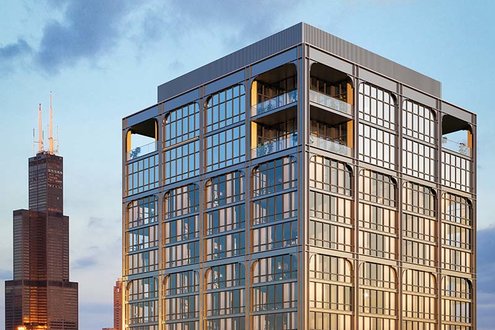 7 min
7 min
Ann Thompson is Executive Vice President of Architecture and Design at Related Midwest1, the largest privately held real estate company in the United States. During her 25 years with the company, she has overseen the design of numerous real estate projects. Ann agreed to share her strategic and engaged vision of architecture with us.
Should architecture undergo a revolution? And if so, how?
Understanding the carbon footprint of the built environment, which accounts for approximately 40% of global carbon emissions, compels us to rethink what and how we build. As architects, we are often the visionaries who first put pen to paper to design a new building, making us a vital part of the ecosystem that creates our cities and neighborhoods. In addition to prevailing considerations like aesthetics and placemaking, the design process is evolving to place a higher value on sustainability and a building’s life cycle. This is the new lens through which we view our success in creating new spaces in which we live, work and recreate.
In our current economic climate, sustainability also plays a crucial role in how projects are underwritten and financed. Both lenders and investors are placing a greater emphasis on ESG performance at both the corporate and asset level. Likewise, as municipalities adopt more stringent decarbonization mandates, developments that are designed to meet or exceed those requirements will not only avoid costly retrofits and penalties, but also benefit from the higher valuations given to green buildings, which typically command higher rents.
A revolution will likely occur as the industry adapts to rapidly emerging technologies, requiring architects to propose new ways of designing and building that leverage these extraordinary resources. The adoption of AI and more specialized building assembly technologies will lead to an increasingly collaborative and inclusive design process, as architects can streamline processes and focus more on the creative and strategic aspects of their work. AI, in particular, can be an incredibly powerful tool, especially when tapped early in the design process. It gives us a much deeper understanding of the impacts of design decisions, allowing us to more accurately project total life cycle costs and address issues that, in the past, might not have been discovered until much later, when they are expensive to fix.
How AI can accelerate the adoption of sustainable construction?
In your opinion, what are the 3 challenges facing the construction sector in the U.S. to accelerate the adoption of more sustainable practices?
One headwind to the widespread adoption of sustainable practices is the upfront investment in green building materials and assemblies. Economic pressures have only risen with inflation, labor shortages and compliance issues. So, while many in the industry support green design, the execution of such projects is difficult without subsidies or other incentives that help offset the higher costs.
Fortunately, there are efforts underway to ease the financial burden for builders and developers. Many are tapping into private grants or government funding sources to invest in energy-efficient systems, such as solar panels, smart glass, or geothermal heating and cooling. And as sustainable construction materials like green concrete and low-carbon steel become more widely adopted—several industry groups have formed to accelerate this process—prices will come down for everyone.
Another challenge will be adapting to the shifting market demand for sustainable buildings and correctly anticipating the preferences and expectations of the millennial and Gen Z generations. Recent studies have shown that many consumers in these age cohorts are concerned about climate change and actively taking measures to limit their environmental impact. Perhaps more importantly, they are willing to pay more for sustainable products. Thus, it’s imperative we design buildings today that will remain attractive to them in the future.
A third challenge is educating our design community and partners on how to evaluate and deploy sustainable technologies effectively. We must continue to provide ongoing education to architects, trade organizations and others involved in our projects. A great example is the local plumbers union in Chicago, which actively educates its workforce on geothermal installation, rainwater harvesting, and other sustainable practices involving water usage. Engagement like this will help drive innovation and adoption across the industry.
ALSO READ: Are we trained effectively to accelerate the transition ?
What do you consider to be the most emblematic recent achievement in terms of sustainable construction?
The long-term benefits created by the Inflation Reduction Act cannot be understated. This landmark legislation makes a historic commitment to building a new clean-energy economy by providing billions of dollars in grants, loans and other investments designed to combat climate change. The act’s provisions specifically aim to make commercial and residential buildings, including federally assisted housing, more energy-efficient and resilient to the impacts of a warming planet.
This act complements the investments made through the Bipartisan Infrastructure Law, which includes $225 million for the Building Codes Implementation for Efficiency and Resilience Program at the Department of Energy. This program is designed to help states support the sustained, cost-effective implementation of updated building energy codes. Together, these initiatives bridge the gap for developers, enabling them to design and build sustainably with financial support and incentives that are necessary.
With the federal government backing these efforts, the adoption of sustainability initiatives will accelerate, driving the real estate sector toward an even more sustainable future—environmentally, socially and financially.
The sustainable project chosen by Ann Thompson
Related Midwest has always prioritized sustainable design and construction methods as part of our commitment to creating better buildings and healthier communities. Our newest residential development, The Row Fulton Market, was recently selected by Green Building Initiative (GBI) as the 2023 Green Globes Project of the Year runner-up and achieved Three Green Globes recognition–only the second building in Chicago to receive this esteemed honor. In addition to advanced energy modeling, high-efficiency HVAC systems, extensive water conservation measures and improved indoor air quality, we prioritized using local suppliers and materials made closer to the construction site to limit carbon emissions from transportation. We also thoughtfully selected vendors who employ environmentally friendly manufacturing processes to ensure we design buildings with quality materials that will stand the test of time.
- Related Companies est une société mondiale d’immobilier qui est la plus importante société immobilière privée des États-Unis. Related a récemment figuré sur la liste des 50 entreprises les plus innovantes du monde établie par le magazine Fast Company.
Upcoming Architects' Perspectives: Feng Deng, architect and associate Professor in the Department of Architecture at Tongji University (China)







